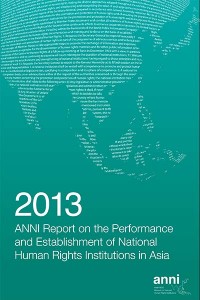2013 ANNI Report on the Performance and Establishment of National Human Rights Institutions in Asia
By Asian NGO Network on National Human Rights Institutions • September 30, 2013 National Human Rights Institutions (NHRIs) have become increasingly prominent actors in the national, regional and international human rights arenas. When able to operate independently and effectively, they are important mechanisms that constitute an effective complement to the judiciary and other institutions in the national infrastructure tasked with the promotion and protection of human rights. This has been evidenced in the 2011 United Nations Human Rights Council (HRC) Resolution, during its 13th regular session; which acknowledged NHRIs as the public protectors of HRDs and encouraged States to reinforce the capacity and mandate of NHRIs to allow them to fulfill their role as Human Rights Defenders (HRDs) effectively. In 2012, the UNHRC adopted by consensus its second resolution on national human rights institutions (NHRIs). The resolution received broad cross-regional support and was co-sponsored by more than 100 States.
National Human Rights Institutions (NHRIs) have become increasingly prominent actors in the national, regional and international human rights arenas. When able to operate independently and effectively, they are important mechanisms that constitute an effective complement to the judiciary and other institutions in the national infrastructure tasked with the promotion and protection of human rights. This has been evidenced in the 2011 United Nations Human Rights Council (HRC) Resolution, during its 13th regular session; which acknowledged NHRIs as the public protectors of HRDs and encouraged States to reinforce the capacity and mandate of NHRIs to allow them to fulfill their role as Human Rights Defenders (HRDs) effectively. In 2012, the UNHRC adopted by consensus its second resolution on national human rights institutions (NHRIs). The resolution received broad cross-regional support and was co-sponsored by more than 100 States.
2012 (and significant events in the first half of 2013) represented a litmus test for many NHRIs in the region. There were significant events for Asian states: such as budding attempts towards democratic transition; and states that faced internal conflict or communal violence, among others. Often, this involved the complicity of state actors, which renders the fight against impunity a formidable challenge.
Download the full report and the Burma chapter.
Tags: Asian NGO Network on National Human Rights Institutions, Burma Partnership, Human Rights, Human Rights Education Institute of Burma, Myanmar National Human Rights CommissionThis post is in: NHRC Monitor
Related PostsMNHRC at the Crossroads; “Alibi” of the Government or Ally of the People?
2015 ANNI Report on the Performance and Establishment of National Human Rights Institutions in Asia
The Myanmar National Human Rights Commission Continues Failing to Deliver
2014 ANNI Report on the Performance and Establishment of National Human Rights Institutions in Asia
Civil Society’s Concerns on Draft MNHRC Law Must Be Adequately Addressed









 All posts
All posts